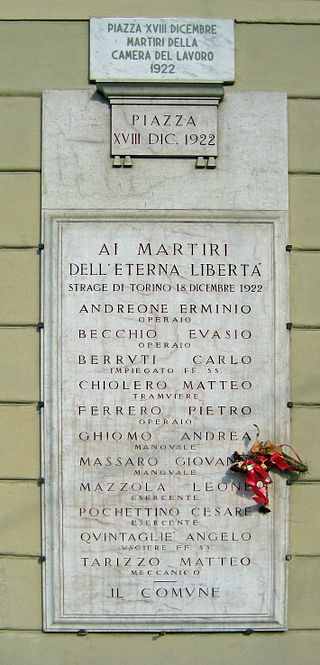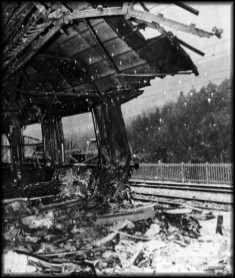Overview
The first judicial investigation led to the condemnation in 1979 of a member of the Brescian far-right movement, Ermanno Buzzi. However, this first sentence was cancelled in 1982, but in 1983 the Court of Cassation declared the appeal process must be redone at the Court of Appeal in Venice. The suspects were acquitted in 1985 by the Court of Venice, and in 1987 by the Supreme Court of Cassation. Buzzi, killed in Novara's prison by neo-fascists Pierluigi Concutelli and Mario Tuti in 1981, was judged "a corpse to be carried out".
A second investigation led to the accusation of other far-right activists: Cesare Ferri, Sergio Latini and Alessandro Stepanoff. They were acquitted for lack of evidence in 1987; in 1989 Ferri and Latini were acquitted of having committed the crime, Stepanoff for lack of evidence.
A third investigation led to a trial for Francesco Delfino (a Carabiniere), Carlo Maria Maggi, Pino Rauti, Maurizio Tramonte and Delfo Zorzi (members of the Ordine Nuovo neo-fascist group). The presence of Tramonte in the place at the time of the blast was confirmed in 2008 by the results of an anthropological forensic test on a picture [2] taken that day. [3]
On 16 November 2010, the Court of Brescia acquitted the defendants (the prosecutor had requested life imprisonment for Delfino, Maggi, Tramonte and Zorzi, and the acquittal for lack of evidence for Pino Rauti). The four defendants were acquitted also in 2012, but in 2014 the supreme Court of Cassation declared the appeal process must be redone at the Court of appeal in Milan for Maggi and Tramonte. Delfino and Zorzi are finally acquitted. On 22 July 2015, the Court of appeal sentenced Maggi and Tramonte to life imprisonment for ordering and coordinating the massacre. [1]
On 21 of June 2017, Tramonte was arrested in Portugal by the Portuguese Police in the Sanctuary of Fátima, while allegedly praying for forgiveness. [4]

The Piazza Fontana bombing was a terrorist attack that occurred on 12 December 1969 when a bomb exploded at the headquarters of Banca Nazionale dell'Agricoltura in Piazza Fontana in Milan, Italy, killing 17 people and wounding 88. The same afternoon, another bomb exploded in a bank in Rome, and another was found unexploded in the Tomb of the Unknown Soldier. The attack was carried out by the Third Position, neo-fascist paramilitary terrorist group Ordine Nuovo and possibly certain undetermined collaborators.

Giuseppe Umberto "Pino" Rauti was an Italian fascist and politician who was a leading figure on the radical right for many years. Involved in active politics since 1948, he was one of founders and, for many years, the leader of the Italian Social Movement (MSI). He was the main representative of the MSI's “moderates”.

Stefano Delle Chiaie was an Italian neo-fascist terrorist. He was the founder of Avanguardia Nazionale, a member of Ordine Nuovo, and founder of Lega nazionalpopolare. He went on to become a wanted man worldwide, suspected of involvement in Italy's strategy of tension, but was acquitted. He was a friend of Licio Gelli, grandmaster of P2 masonic lodge. He was suspected of involvement in South America's Operation Condor, but was acquitted. He was known by his nickname "il caccola" as he was just over five feet tall - although he stated that originally, the nickname came from his very young involvement, at age 14, in the Italian Social Movement (MSI), a neo-fascist political party established after the war
Ordine Nuovo was an Italian far right cultural and extra-parliamentary political and paramilitary organization founded by Pino Rauti in 1956. It had been the most important extra-parliamentary neofascist organization of the post-war Italian republic.

The Bologna massacre was a terrorist bombing of the Bologna Centrale railway station in Bologna, Italy, on the morning of 2 August 1980, which killed 85 people and wounded over 200. Several members of the neo-fascist terrorist organization Nuclei Armati Rivoluzionari were sentenced for the bombing, although the group denied involvement.

The Italicus Express massacre was a terrorist bombing in Italy on a train of the public rail network. During the early hours of 4 August 1974, the bomb attack killed 12 people and wounded 48. Responsibility was claimed by the neo-fascist terrorist organization Ordine Nero.
Vincenzo Vinciguerra is an Italian neo-fascist activist, a former member of the Avanguardia Nazionale and Ordine Nuovo. He is currently serving a life-sentence for the murder of three Carabinieri by a car bomb in Peteano in 1972. The investigation in this previously unsolved affair by prosecutor Felice Casson led to the revelation of "Gladio" networks around Western Europe.
Roi Zorzi, presently known as Roi Hagen (波元路伊), is an Italian-born Japanese neo-fascist.

Pietro Valpreda was an Italian anarchist, poet, dancer and novelist.

In Italy, the phrase Years of Lead refers to a period of political violence and social upheaval that lasted from the late 1960s until the late 1980s, marked by a wave of both far-left and far-right incidents of political terrorism and violent clashes.

Franco "Giorgio" Freda is one of the leading neo-Fascist intellectuals of the post-war Italian far-right. He founded a publishing house for neo-Nazi thought, and described himself as an admirer of Hitler. He was convicted but later acquitted for lack of evidence for involvement in the Piazza Fontana bombing. He founded the Fronte Nazionale, which was disbanded by the Italian government in 2000 when Freda and forty-eight other members were found guilty of attempting to re-establish the National Fascist Party.

Carlo Cicuttini was an Italian-born, naturalized Spaniard neofascist terrorist.

The 1922 Turin massacre refers to the attack by Italian Fascists against members of a local labour movement in Turin in Italy. Over three days starting on 18 December and ending on 20 December 1922, at least 11 workers were killed in a terror campaign from 18 to 20 December 1922, to break the resistance to Fascism by the labour movement and working class.

The Train 904 bombing was a terror attack which occurred on 23 December 1984, in the Apennine Base Tunnel. A bomb on the 904 express train from Naples to Milan was detonated, killing 16 and wounding 266. The bombing location was near the location of the Italicus Express bombing ten years previously.
Post-fascism is a label that identifies political parties and movements that transition from a fascist political ideology to a more moderate and mainline form of conservatism, abandoning the totalitarian traits of fascism and taking part in constitutional politics.

The Ordine Nero was an Italian terrorist fascist group founded in 1974 following the dissolution of the fascist Ordine Nuovo. Between 1974 and 1978, bombings by ON led to a number of woundings and deaths, having orchestrated several deadly bombings and murders including the 1974 Italicus Express Bombing and the 1974 Brescia Bombing.

The Peteano massacre was a neo-fascist terrorist attack which occurred on May 31, 1972 in Peteano, a frazione of Sagrado (Gorizia), Italy. An anonymous call led five carabinieri to check a suspicious car, which turned out to be a car bomb that exploded when the door was opened. Three carabinieri were killed.
In the First Italian Republic, after the Second World War, many armed, paramilitary, far-right organizations were active, as well as far-left ones, especially in the Years of Lead.
Carlo Digilio, also known as Zio Otto, was an Italian terrorist, soldier, and self-styled secret agent. He belonged to the neo-fascist group Ordine Nuovo and later became a collaborator. At the end of the first-degree process, he was convicted for the Piazza Fontana bombing, but the reliefs of law extinguished his guilt. He was also involved in the Piazza della Loggia bombing.
Paolo Signorelli was an Italian author, activist, and politician of the extreme right.












